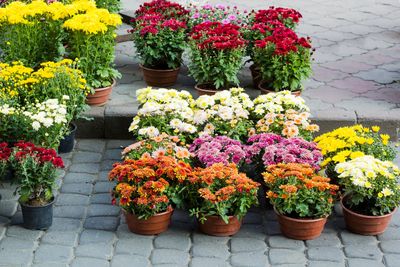What is Container Monoculture Design?
Gardeners generally shy away from monoculture. It’s not considered good practice because putting the same types of plants in the same space encourages the accumulation of pests and disease particular to those plants. The difference between that traditional idea of monoculture and monoculture container groupings is that with containers you can more easily swap out diseased plants. You can also disinfect and change out pots to prevent the spread of a disease. Additionally, the new trend in monoculture is not necessarily to use the same type of plants, say all begonias. The idea is to use plants with similar colors and textures. This creates a monoculture feel without the risks typically associated with the practice.
How to Create a Container Monoculture Garden
Your monoculture container garden could be as simple as creating monochromatic floral arrangements with pots. For instance, you may choose yellow daffodils and tulips for spring and then yellow pansies, yellow tuberous begonias, or even yellow roses to create a pretty, golden palette. There are also more considerations than just grouping containers of the same color if you want to create an especially spectacular monoculture group. First, start with a variety of containers. Choose containers of all one type, like terracotta, for instance, and then select various sizes and heights to create levels and visual interest. Next, the fun part is to choose your plants. Choose one color palette, one texture, or one type of plant. Some ideas include using only succulents, plants with just one color of flowers, or only plants with attractive foliage. Choose a location for your monoculture container garden. Some good choices include around the edges of a patio or porch, along the sides of a walkway, at the entrance to your garden or backyard, or against the side of the house. Finally, arrange your containers. Even with pots of different sizes, your arrangement will be more striking with added levels. Use turned over pots or plant stands to create different heights and levels. Arrange until you like how it looks, and of course since you are using containers you can change the arrangement at any time.
